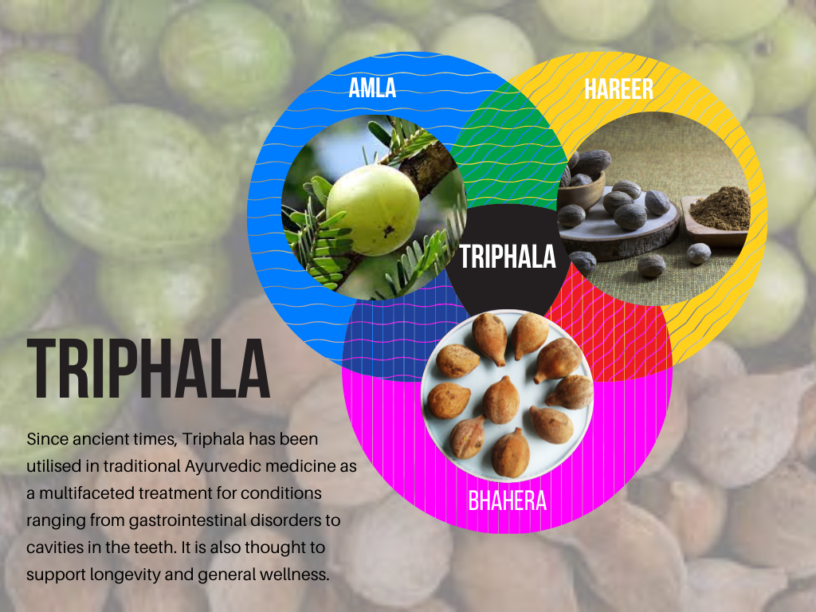
Since ancient times, Triphala has been utilised in traditional Ayurvedic medicine as a multifaceted treatment for conditions ranging from gastrointestinal disorders to cavities in the teeth. It is also thought to support longevity and general wellness.
It is regarded as a polyherbal medication because it contains a variety of therapeutic plants. Ayurvedic medicine, a traditional system that places an emphasis on disease prevention and health promotion, is well known for its use of polyherbal formulations.
Combining synergistic herbs is said to increase therapeutic effectiveness and provide for a more potent remedy than using just one of the ingredients separately.
The dried fruits of the following three Indian native plants are combined to make Triphala.
Amla (Emblica Officinalis)

Amla also referred to as Indian gooseberry, is significant in Ayurvedic treatment.
It is one of the earliest edible fruits that India is aware of. The edible fruit of a small to medium-sized tree that is common throughout India is called Indian gooseberry.
The berries have a fibrous texture and a strong, acidic flavour. Because of this, the berries are frequently cooked into meals, pickled, or soaked in sugar syrup.
Indian gooseberry and its extract are used in Ayurvedic medicine to treat symptoms like constipation and also used in cancer prevention. Indian gooseberries are very nutritious and high in vitamin C, amino acids and minerals. They also contain powerful plant compounds like phenols, tannins, phyllembelic acid, rutin, curcuminoids and emblicol .
Several test-tube studies suggest that Indian gooseberries have potent anti-cancer properties. For instance, Indian gooseberry extract has been demonstrated in test-tube tests to suppress the growth of cervical and ovarian cancer cells. However, there is no proof that Indian gooseberries can protect against human cancer.
Bhaira (Terminalia bellirica)

Southeast Asia is home to the huge tree known as Terminalia bellirica. The fruit of the tree is used as a therapy for common illnesses like bacterial and viral infections and is referred to as “Bhaira” in Ayurvedic medicine.
Bhaira is believed to have medicinal properties because of the presence of tannins, ellagic acid, gallic acid, lignans, and flavones, among many other potent plant chemicals.
Bhaira is also commonly used in Ayurvedic medicine to treat diabetes and blood sugar dysregulation.
This is because Bhaira is high in gallic acid and ellagic acid, two phytochemicals that have beneficial effects on blood sugar levels, insulin sensitivity and body weight.
These plant chemicals help promote insulin secretion from the pancreas and have been shown to reduce high blood sugar and improve insulin resistance in animal studies.
Harir (Terminalia chebula)

The Middle East, India, China, and Thailand are all home to the medicinal tree Terminalia chebula. The small, green fruit of the Terminalia chebula tree, which is utilised in medicine, is referred to as this plant in Ayurveda as “Haritaki.” It is one of Triphala’s key ingredients. In Ayurveda, Haritaki is highly revered and frequently referred to as the “king of medicines.”
Since ancient times, it has been used as a treatment for several maladies, including heart disease, asthma, ulcers, and stomach aches. Terpenes, polyphenols, anthocyanins, and flavonoids are just a few of the phytochemicals found in haritaki that have been shown to offer significant health advantages. Haritaki contains strong anti-inflammatory and antioxidant qualities, according to studies.
How to use Triphala
Generally, the dosage is decided according to the severity of the problem but a dose of half tsp in the morning after a meal and also the same in the evening after a meal is recommended for all who are using Triphala for general health maintenance.





Leave a Reply